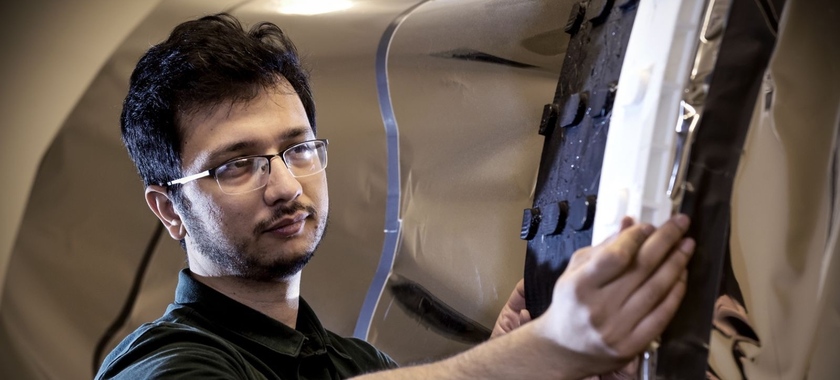When the Celestial Laboratories team entered the inaugural Airlock Competition, a cross-Canada competition for universities organized by the University of British Columbia’s Mars Colony group, they didn’t expect to be awarded first prize in both phases and win the entire competition.
“It was very surprising because we don't have an aerospace department at the University of Regina unlike the other universities involved, some of which also have additional programs in space exploration,” said Anwit Adhikari, Chief Designer at Celestial Laboratories.
Having to innovate without influence from other programs and companies gave Celestial Laboratories the benefit of starting with a blank slate and allowed the team to stay focused on the basic propositions of the problem.
“We were successful because we started with first principles, and were not afraid of where that would lead us.”
In recent years, there has been momentum around sending astronauts to Mars, but less focus has been given to what happens when astronauts get to the planet and face the technological challenges the Martian environment creates.
Celestial Laboratories was founded by a group of University of Regina students interested in tackling these challenges and solving the specific problem the Mars Colony Airlock Competition presented: How would you successfully build an airlock for astronauts on Mars?
With space exploration, astronauts face two main challenges: (1) Surviving in a hostile environment and (2) bringing everything they need to work and survive in that hostile environment.
Airlocks solve the first challenge by creating a safe bridge between two disparate environments – a habitation environment and a hostile host. To solve the second challenge, space exploration missions for low orbit and lunar surfaces have relied upon inflatable technologies to collapse the airlock structure, making transport easier.
While Mars may technically be more hospitable than the Moon because it at least has an atmosphere, the planet’s unique surface temperature, atmospheric conditions, gravitational pull and wind loads present far more technological challenges in the interim.
During the design phase of the competition, the Celestial Laboratories team realized that inflatable technologies would not be suitable to use and that the Martian environment presented two new technological hurdles to building an airlock. First, they knew they needed to create a collapsible solid structure endoskeleton. Second, they would need to create a ventilation system to make Martian air breathable for humans.
These challenges may seem insurmountable for some, but the Celestial Laboratories team tackled them head-on.
“With any engineering project, you're going to find a lot of challenges and there has to be a willingness to just persevere,” says Adhikari.
Adhikari says the dedication and ingenuity of the Celestial Laboratories team was critical to its success, specifically Samuel Reddekop, who had a crucial role in developing the electronic control system for the airlock and single-handedly designed and built the entire electronic control system.
“From our team, there was a commitment and a lot of curiosity. And it was a lot of fun.”
After hundreds of iterations, Celestial Laboratories developed solutions for both problems: A modular, accordion-style collapsible airlock that can handle the structure loads of Mars and allows astronauts to remove and repair components; and, a ventilation system that processes Martian air on multiple variables, such as carbon and oxygen content, electromagnetically charged particles, temperature and pressure.
The ventilation system is a feat in engineering because it is built around a unique complex compressor unlike anything in the world.
“We assessed that there was no compressor on this planet that met our needs – a volume-efficient, lightweight compressor that can handle radiation and solar support. So, we decided to invent our own,” says Adhikari. “The compressor is truly unique.”
The two designs Celestial Laboratories presented at Phase I and II of the Mars Colony competition were awarded Best Martian Airlock Design and Best Martian Airlock Design/Prototype.
The team has found a home at Innovation Saskatchewan’s research and technology park in Regina and feels ready to hit its next two major milestones – an airlock prototype demonstration and acquiring a client in the aerospace industry.
“We are one of the few organizations in North America consistently working on these unique and niche technologies,” says Adhikari. “Given our two national awards, we must be doing something right and I think we are well positioned to claim we have something valid to show the aerospace industry.”
The team is also focusing on diversifying its technologies for additional applications and avenues for growth on Earth.
For example, the compressor’s distinct features – its donut shape, lack of springs or magnets due to their susceptibility to temperature and radiation fluctuations, and capacity to have multiple attachable components like a heater, filter and carbon dioxide scrubber – could prove particularly useful in creating breathable air for human and improving quality of life in hostile environments like natural disasters, underwater or in mines.
Although Celestial Laboratories occupies a very niche field within the aerospace industry and an atypical sector in Saskatchewan’s innovation ecosystem, Adhikari thinks Saskatchewan is uniquely suited for this industry, and the province could have a much more significant impact in it.
“The talent in Saskatchewan is world-class, and the weather is a lot more similar to Mars than you’d find in other places,” says Adhikari. “This can be a unique breakout point for Saskatchewan and Canada in the aerospace industry.”
With the incredible ingenuity and innovation of the Celestial Laboratories’ team and the opportunities within the province, Celestial Laboratories’ success seems well beyond the sky's limit.


